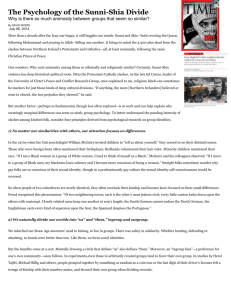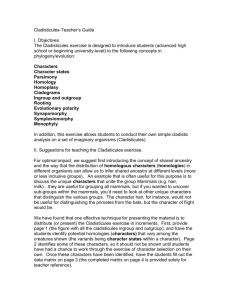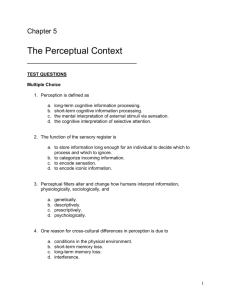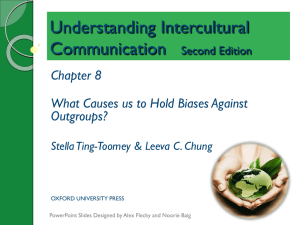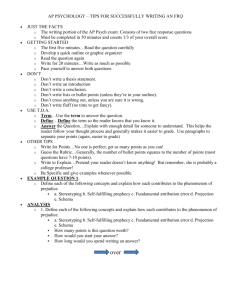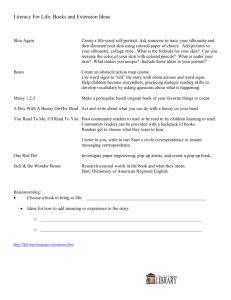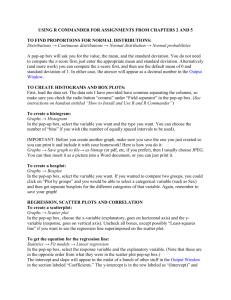Chapter 8
advertisement
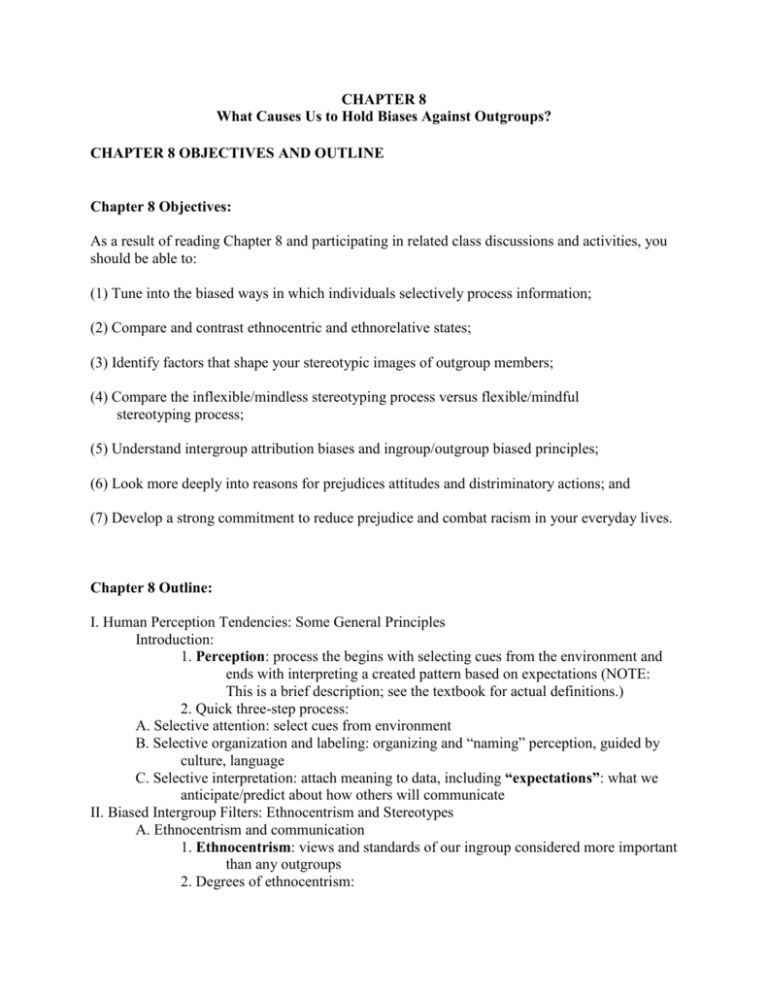
CHAPTER 8 What Causes Us to Hold Biases Against Outgroups? CHAPTER 8 OBJECTIVES AND OUTLINE Chapter 8 Objectives: As a result of reading Chapter 8 and participating in related class discussions and activities, you should be able to: (1) Tune into the biased ways in which individuals selectively process information; (2) Compare and contrast ethnocentric and ethnorelative states; (3) Identify factors that shape your stereotypic images of outgroup members; (4) Compare the inflexible/mindless stereotyping process versus flexible/mindful stereotyping process; (5) Understand intergroup attribution biases and ingroup/outgroup biased principles; (6) Look more deeply into reasons for prejudices attitudes and distriminatory actions; and (7) Develop a strong commitment to reduce prejudice and combat racism in your everyday lives. Chapter 8 Outline: I. Human Perception Tendencies: Some General Principles Introduction: 1. Perception: process the begins with selecting cues from the environment and ends with interpreting a created pattern based on expectations (NOTE: This is a brief description; see the textbook for actual definitions.) 2. Quick three-step process: A. Selective attention: select cues from environment B. Selective organization and labeling: organizing and “naming” perception, guided by culture, language C. Selective interpretation: attach meaning to data, including “expectations”: what we anticipate/predict about how others will communicate II. Biased Intergroup Filters: Ethnocentrism and Stereotypes A. Ethnocentrism and communication 1. Ethnocentrism: views and standards of our ingroup considered more important than any outgroups 2. Degrees of ethnocentrism: a. Distance of indifference (low): lack sensitivity b. Distance of avoidance (moderate): nonverbal lack of attention, avoidance, and language switching with outgroup members c. Distance of disparagement (high): racist jokes, hate speech 3. Developmental Model of Intercultural Sensitivity a. Three states of ethnocentrism i. Denial of cultural difference ii. Defense against cultural difference iii. Minimization of cultural difference b. Three states in development of ethnorelatiivism i. Acceptance of cultural difference ii. Adaptation of cultural difference iii. Integration of cultural difference: B. Stereotypes and communication 1. Stereotypes: exaggerated pictures of group on basis of inflexible beliefs and expectations 2. Overgeneralization of group without attempt to perceive individual variations. 3. Stereotype Content Model forms along two dimensions: a. Perception of warmth: whether cooperation or competition b. Perception of competence: whether high or low status C. Stereotypes: We Are What We Watch 1. Media create “character types,” shape way we view dissimilar others 2. Stereotyping is inevitable a. Inflexible stereotyping: negative stereotyping on automatic pilot b. Flexible stereotyping: “mindfully minding our mind”—awareness III. Marking Ingroup/Outgroup Membership Boundaries A. Us versus them 1. Social identity theory: study of ingroup and outgroup membership 2. Intergroup communication: individuals in one group interact with another group (or members) in terms of their group membership identification 4. Ingroup favoritism principle: positive attachments and predisposition for norms and behaviors related to one’s group B. Where do I fit in? 1. Membership in an ingroup is a matter of degree and variation 2. The more association with ingroup, the greater expected conformity 3. Ingroup membership provides security and inclusion 4. Ingroup member can feel like outgroup member: because he or she is not accepted by ingroup members C. Intergroup attribution biases 1. Attribution: explanation, meaning of why people behave as they do 2. Three biases that typically occur during intergroup encounters: a. Fundamental attribution error: overestimate negative personality factors to explain stranger’s negative event and underestimate situational factors b. Principle of negativity: emphasize negative information about outgroup members c. Favorable self-bias and other-derogation principle: tendency to favor our ingroup in explaining success and to derogatory explanations for ougroups’ successes d. Self-effacement bias: remember our failures, attribute to lack of ability IV. Shattered Lens: Prejudice, Discrimination, and Racism A. Prejudice: multiple explanations and functions 1. Prejudice: indiscriminate negative feelings and predispositions toward outgroup members (but it can also mean the opposite) 2. Four explanations for development of prejudice: a. Exploitation theory: higher status/power group restrains lower b. Scapegoating theory: blame minority groups for one’s failures c. Authoritarian personality approach: personality type rigidly adheres to norms, completely accepts those in authority d. Structural approach: institutions promote “pecking order” 3. The communication functions of prejudice a. Ego-defense mechanism: protect ego via outgroup blame b. Regularity: need to view own cultural values, norms, and practices as the proper way of thinking c. Lacking accurate cultural knowledge: ignore the unfamiliar d. Rewards and approval: received from ingroup members B. Prejudiced remarks … or innocent jokes? 1. In unconscious incompetence stage, mindless act still offends 2. Tools spreading prejudice by cyberbullies are available to victims to respond C. 4 discriminatory practices 1. Discrimination: verbal and nonverbal actions that carry out prejudiced attitudes 2. Four types of discriminatory practices a. Isolate discrimination: intentional harm of outgroup individual b. Small-group discrimination: (unapproved) set of individuals in ingroup harm outgroup members c. Direct institutional discrimination: community-prescribed endorsement of discrimination d. Indirect institutional discrimination: unintentional, but harmful broad practice D. Different types of racism 1. Racism involves three principles a. Feelings of superiority based on biological or racial differences b. Strong ingroup preferences, rejection of “different” outgroups c. Doctrine that conveys special advantage to those in power 2. Examples of racism: a. Racial profiling: intentionally or unintentionally promotes unfair treatment b. Perpetuating stereotypic images: majority group present selves positively and minority group negatively c. Hate crimes: hostility to the victim as a member of a group E. Reducing prejudice and racism: four guidelines: 1. Be honest, confront unchecked biases and ethnocentric attitudes 2. Check for bias when you evaluate behavior of outgroup member 3. Negative images concerning outgroup will distort perceptions 4. Communicate your feelings assertively toward racist remarks V. Intercultural Reality Check: Do-Ables Flexible communicators will reduce prejudice and racism in the following ways: A. Start with a clean slate: be flexible with your first best guesses B. Use your most precious gift: your brain; be open to multiple perspectives C. Continue learning about those around you D. Remember, all of us are works in progress E. Stereotyping is inevitable, but still actively engage in flexibly “minding” your own social categorization process CHAPTER 8 CHECK-UP Check out the following cultural literacy questions and self-assessment questions: Breakfast Quiz: Where are these served as typical breakfasts? 1. Warm or cold soybean milk served with a variety of condiments, including dried pork or shrimp, preserved cabbage, scallions, soy sauce, and vinegar topped with deep fried breadsticks. 2. Rice with sambar (lentils, spice, and vegetables), fish and rice stew, a yogurt salad, and tropical fruit. 3. Soft boiled eggs, cereal, cheese, spreadable liver sausage, ham or other cold cuts, rolls, and mixed bread. Choices: (a) Germany (b) India (c) Northern China, Taiwan, and Hong Kong POP-UP ANSWERS: 1 (c) Northern China, Taiwan, and Hong Kong 2 (b) India 3. (a) Germany NOTE: Consider your own reactions to this sample of the wide variety of breakfast foods around the world. Could you be feeling some “ingroup favoritism” (My breakfast is appetizing) and “outgroup derogation” (Their breakfasts are strange or even badtasting)? Self-Assessment Quiz: Use this quiz to learn about ethnocentrism and tolerance of ambiguity. Choose whether you tend to agree or disagree with the following statements: 1. My culture provides the best opportunity for its members to achieve their goals. a. Agree b. Disagree 2. I like routines and a stable environment. a. Agree b. Disagree POP-UP INTERPRETATION: 1a. Strong agreement with this statement reflects a tendency toward ethnocentrism. Check out my.blog 8.1 in the text on page 162 to take a full assessment of these two tendencies. POP-UP INTERPRETATION: 1b. Strong disagreement with this statement reflects a tendency away from ethnocentrism. Check out my.blog 8.1 in the text on page 162 to take a full assessment of these two tendencies. POP-UP INTERPRETATION: 2a. Strong agreement with this statement reflects a tendency toward a lower tolerance of ambiguity. Check out my.blog 8.1 in the text on page 162 to take a full assessment of these two tendencies. POP-UP INTERPRETATION: 2b. Strong disagreement with this statement reflects a tendency away from a tolerance of ambiguity. Check out my.blog 8.1 in the text on page 162 to take a full assessment of these two tendencies. CHAPTER 8 GLOSSARY-MATCHING QUIZ Match the following five terms with their respective definitions: a. Discrimination b. Racism c. Stereotype d. Ethnocentrism e. Prejudice ___ 1. Exaggerated pictures we make about a group of people on the basis of our inflexible beliefs and expectations about the characteristics or behaviors of the group. ___ 2. Describes an individual’s feelings and predispositions toward outgroup members in a pejorative or negative direction. ___ 3. Considering the views and standards of one’s own ingroup as much more important than any outgroup’s. ___ 4. Verbal and nonverbal actions that carry out prejudiced attitudes. ___ 5. Feelings of superiority based on biological or racial differences, or both, along with strong ingroup preferences and rejection of outgroups that are different in custom or belief. POP-UP ANSWER: 1. c 2. e 3. d 4. a 5. b Match the following five terms with their respective definitions: a. Selection b. Perception c. Interpretation d. Attribution e. Organization ___ 1. The process of selecting cues from the environment, organizing them into a clear pattern and labeling that pattern, and then interpreting that pattern. ___ 2. The explanation for, or the meaning of, why people behave as they do. ___ 3. Guided by our culture and the language we speak, grouping our perceptions into similar objects and labeling them with a symbol or name. ___ 4. Attaching meaning to the data that we have received and grouped into a pattern; also known as expectations. ___ 5. Picking out cues from one’s cultural landscapes, having learned to pay close attention to the cues that are valuable in one’s culture. POP-UP ANSWER: 1. b 2. d 3. e 4. c 5. a Match the following five terms with their respective definitions: a. Ingroup favoritism principle b. Fundamental attribution error c. Principle of negativity d. Favorable self-bias and other-derogation principle e. Self-effacement bias ___ 1. To place more emphasis on negative information concerning outgroup members. ___ 2. Remembering one’s failures more and attributing those failures to one’s lack of ability. ___ 3. Positive attachment to and predisposition for norms and behaviors that are related to one’s group. ___ 4. Attributing one’s positive events to positive dispositional factors and creating derogatory explanations for outgroup successes. (“I received an A on the exam because I’m smart but those people received As and they must have cheated.”) ___ 5. Overestimating negative personality factors in explaining a stranger’s negative event and underestimating situational factors. (“That stranger got in a car crash. He must have been drunk; it couldn’t have had anything to do with the slippery roads or that the light wasn’t working.”) POP-UP ANSWER: 1. c 2. e 3. a 4. d 5. b CHAPTER 8 REVIEW QUIZ Multiple Choice: Select and click the BEST ANSWER from the choices available. 1. _______________ derives from two Greek words, meaning “one’s own ethnic or cultural group” and “one’s group should be looked upon as the center of the world.” a. Fundamental attribution error b. Prejudice c. Discrimination d. Ethnocentrism POP-UP ANSWER: d. Ethnocentrism (p. 161) 2. During the ____________ part of the perception process, the cues that are considered valuable in one’s culture are what one pays closer attention to. a. perception b. selection c. attribution d. organization POP-UP ANSWER: b. selection (p. 160) 3. When three individuals in the United States commit a hate crime against a person due to that person’s sexual orientation, they are engaging in what kind of discrimination? a. Direct institutional b. Indirect institutional c. Small-group d. Isolate POP-UP ANSWER: c. Small-group (p. 174) 4. Harve, who is from Belgium, has feelings of hostility toward the Dutch, and tends to have negative views of Dutch people’s behaviors and characteristics, although he has never taken any harmful action against them. He is __________ toward the Dutch but has not practiced ______________ against them. a. prejudiced; discrimination b. racist; prejudice c. prejudiced; attribution d. stereotyping; prejudice POP-UP ANSWER: a. prejudiced; discrimination (pp. 171 and 174) This one is difficult, but is designed to teach you that prejudice is an inner attitude and discrimination is outward action or behavior. 5. Hadiya has been walking down the street and been the recipient of racist jokes and hate-filled remarks. She is the victim of what degree of ethnocentrism? a. Distance of indifference b. Distance of avoidance c. Distance of disparagement d. Distance of violence POP-UP ANSWER: c. Distance of disparagement (p. 164) 6. Hajna believes that her native Hungarian customs, beliefs, and ways of doing things are superior to other cultures. Hajna is engaging in ________________. a. disparagement b. indifference c. ethnocentrism d. attribution POP-UP ANSWER: c. ethnocentrism (p. 161) 7. Harriet points to a positive ____________ attribution (her friendliness), as the reason for her job promotion, and to a(n) _____________ attribution (he’s lucky) as the reason for his job promotion. a. dispositional or personality; situational b. situational; dispositional or personality c. personal; social d. social; personal POP-UP ANSWER: a. dispositional or personality; situational (p. 170) 8. The ___________________ of the development of prejudice suggests that prejudiced individuals believe that they are victims of society, and so blame a minority group for their plight. a. exploitation theory b. scapegoating theory c. authoritarian personality approach d. structural approach POP-UP ANSWER: b. scapegoating theory (p. 171) 9. Helga is from the Netherlands and believes her nation is highly competitive with Norway. So, according to the Stereotype Content Model, the perception of ___________ dimension between the Netherlands and Norway is low. a. ethnocentrism b. competition c. competence d. warmth POP-UP ANSWER: d. warmth (p. 166) 10. When a minority coworker was laid off, Hakeem decided that it was much more likely due to the coworker’s “laziness” and not the fact that there had been a significant drop in customer orders. Hakeem is engaging in which attribution error? a. Fundamental attribution error b. Self-effacement bias c. Principle of negativity d. Favorable self-bias and other-derogation principle POP-UP ANSWER: a. Fundamental attribution error (p. 170) True/False: In order to identify the best answer, consider whether each statement is true (i.e., accurate) or false (i.e., inaccurate). Click either “a” for “True” or “b” for “False.” 1. If we are mindful, we can stop stereotyping. a. True b. False POP-UP ANSWER: b. False (It is inevitable that we stereotype, but we can engage in a mindful process of loose stereotyping.) (p. 167) 2. Prejudice relates to attitude and discrimination relates to action or behavior. a. True b. False POP-UP ANSWER: a. True (pp. 171 and 174) 3. When we make interpretations, we attach meaning to the data we receive. a. True b. False POP-UP ANSWER: a. True (p. 160) 4. When Hamish feels negative or hostile feelings toward outgroup members but takes no action, he is engaging in small-group discrimination. a. True b. False POP-UP ANSWER: b. False (p. 174) 5. Our perceptions of others are usually highly subjective, selective, and biased. a. True b. False POP-UP ANSWER: a. True (p. 161) CHAPTER 8 INTERCULTURAL WEB SURFING Check out the following Internet site and other resources that are relevant to this chapter: Read more about the Intercultural Tour “Chink” controversy at: http://www.chinkssteaks.com Strangers. This short film is inspirational and relevant to stereotypes and perceptions. http://www.youtube.com/watch?v=RpjHSiQLPmA Moon walking bear is a clip about perception. http://www.youtube.com/watch?v=47LCLoidJh4&feature=player_embedded Susan Boyle’s debut on Britain’s Got Talent. http://talent.itv.com/2009/videos/video/item_200081.html Wes Kim’s classic short film about the choices we make … without thinking. http://www.mediathatmattersfest.org/films/vision_test Films: Crossing Over (2009). A drama about several individuals living in Los Angeles and struggling to attain U.S. citizenship. The film deals with the border, document fraud, the asylum and green card process, work-site enforcement, and also the clash of cultures. Boys Don’t Cry (1999). The true story of the life of Teena Brandon. Teena was a transgendered (genetically female, emotionally male) youth who preferred life in her male identity as Brandon Teena. Brandon moves to Nebraska, makes friends, and finds a girlfriend. When Brandon's best friends make this discovery, his life eventually is ripped apart by betrayal, humiliation, rape, and ultimately murder. Book: Michael Lewis (2006). The Blind Side: The Evolution of a Game. New York: W. W. Norton & Company. This book explores the game of football, but more important, the amazing story of U.S. football player Michael Ohr. CHAPTER 8 INTERCULTURAL TOUR Check out the following intercultural scenario: A NEWS STORY: TO EAT STEAK OR NOT?* Susannah Park, a Korean American, was eating lunch with some friends. They struck up a conversation about current events and her friend mentioned a restaurant in Wissinoming, PA, called “Chink’s.” Opened in 1949 by the late Samuel “Chink” Sherman, the steak shop has become a neighborhood legend. Chink’s Steaks was voted Best of Philly for cheesesteaks by Philly Magazine in 2002. Joseph Groh is the current owner of Chink’s Steaks. Susannah Park, however, was horrified. She called the restaurant owner and requested that he consider changing the name of the shop because “having a restaurant with that name ... is telling the world that ‘chink’ is an appropriate term and that it’s not a racial slur,” Park said. Joseph Groh refused. “The restaurant has been here fifty-five years and no one has ever questioned it,” said Groh. “Besides, everybody is welcome here! I know there are lots of racist people in the world, but I’m not one of them.” Sam Sherman’s widow, Mildred Sherman, says that Sam got the nickname “Chink” when he was six, because of his slanty eyes. Many people didn’t learn of his real name until they attended his funeral in 1997. Sherman said the nickname is etched on her husband’s gravestone. She called the controversy “ridiculous.” “We are Jewish people. We are far from racists. We have Chinese customers!” Sherman claimed. “My husband was well-loved by everybody in this town.” Park thinks that the restaurant name hasn’t become a controversy because it is in a neighborhood that is largely white and because the Asian community is not very outspoken. She hopes bringing attention to this will help educate people. The restaurant name is just “another reminder of how much cultural insensitivity there still is around us,” she said. What should Susannah Park do? *Source: Adapted from a news story written by Myung Oak Kim (2004, January 9). Contact: kimm@phillynews.com. REFLECTION QUESTIONS: 1. Can you understand why Park was upset about a restaurant named “Chink’s”? 2. Can you understand why both Groh and Sherman were upset about Park’s request? 3. Select a number on a scale from 1 to 10, with 1 = strongly disagree and 10 = strongly agree, to indicate whether you believe that Groh should change his restaurant’s name. 4. If the Philly steakhouse was given a new name such as “Honky’s,” “Jew Boy’s,” “Dyke’s,” “Faggot’s,” “Nigger’s,” “Wetback’s,” or “Redskin’s,” would you have any objections to the use of any of the terms? Would you still eat steak there? FURTHER APPLICATION PROBES Let’s apply some concepts from Chapter 8 to the scenario. 1. Which of the following “communicative distances” do the owner’s comments about the controversy being “ridiculous” reflect? a. Distance of indifference b. Distance of avoidance c. Distance of disparagement POP-UP ANSWER: The answer here is that it may depend on the receiver of the message. Although it appears that the owners believed that the name was not disparaging, for Park, the use of the name felt like disparagement (racist jokes or hate-filled speech used to downgrade outgroup members). 2. Which of the following types of discrimination does the scenario reflect? a. Isolate b. Small-group c. Indirect institutional d. Direct institutional POP-UP ANSWER: c. Indirect institutional (p. 175) (Institutions such as business licensing agencies allowed this restaurant’s name to occur; this was probably unintentional discrimination on the part of the institution.) 3. Chapter 8 gave some examples of racism. Which type of racism does this scenario reflect? a. Racial profiling b Perpetuating stereotypic images c Hate crimes POP-UP ANSWER: b. Perpetuating stereotypic images (p. 176) 4. To reduce prejudice and discrimination, which should Park do? a. Realize that we are all works in progress and wait for change. b. Speak up assertively. POP-UP ANSWER: b. Speak up assertively (see “Reducing Prejudice and Racism” on p. 177). While it is true that all individuals are works in progress, this public discrimination or insensitivity should be addressed. CHAPTER 8 CLASS HANDOUTS Note: Your instructor may ask you to download, print out, and/or e-mail the following class handouts for this chapter: A CRITICAL INCIDENT: “FRIENDLY TEASING OR …? INTERACTIVE PROBES FOR “FRIENDLY TEASING OR …? A CRITICAL INCIDENT: FRIENDLY TEASING OR VERBAL HARASSMENT? A few months ago Jessica Martinez had just graduated from a well-respected, local university with a degree in mass communications. She had several offers, but the most exciting, not to mention the one closest to home, was with TechnoloComm. She was hired in the human resources office to work on internal newsletters and publicity. Everything went well for the first week or two, and then something happened that made her question her job and the organization. It was last Monday morning, and she joined a conversation with her coworkers, Peter and Alex. Peter and Alex were working together on other projects. So, when she saw them in the coffee room, she thought this was a great chance to get to know them. First Episode: "Hi, Jessica," said Peter enthusiastically. "We were just talking about the big street party last weekend." "Yeah," chimed in Alex. " I was really frustrated because I couldn’t get into my neighborhood. Did you experience the same problem?" After pausing, he added, "I guess not, since you probably don't live on the north side of town." "Yeah, you must live in the el barrio, right?" questioned Peter, making sure to try to give a Latin twist to el barrio. Jessica felt her face flush; she nodded slightly, and faked a laugh. Jessica lived with her family in a traditionally Hispanic area of town and would never want to live anywhere else. Her neighborhood was home. It was where she had grown up and where she knew everyone. Before she could think of a good response, the men headed back to their desks. Jessica's gut reaction was: "Why do they assume I live in the barrio? I could live anywhere; I just don't want to and my family doesn't want to either." After thinking about the conversation for a while, though, she decided to try to forget it, thinking, "It might be a verbal misunderstanding; I just need to focus on my own job." Second Episode: A week later, the three of them bumped into each other again in the coffee room on a Monday morning. Peter asked "Hey, guys, how was your weekend?" Alex replied, "Great! I got together with my family and had a surf and turf barbecue." Jessica responded: "Sounds yummy. I love barbecue!" Peter commented, "I'm surprised to hear that." With a surprising and innocent tone, Jessica asked: "Why's that?" Peter replied: "Well, you know, I've always heard that Hispanics don't like to barbecue." Jessica responded with an irritated voice, "And, pray tell, why not?" "Well," Peter said, "because the beans fall through the grill!" At this point, both Peter and Alex started laughing as Jessica responded with total disgust, "You guys are totally hopeless!" and she walked away with her heart pounding. Source: Adapted from: Mary Meares and John Oetzel (2004), Chapter 31: “A Case of Mistreatment at Work?” In J. Keyton and P. Shockley-Zalabak (Eds.) Case Studies for Organizational Communication. Los Angeles, CA: Roxbury. NAME: _______________________________ INTERACTIVE PROBES FOR “FRIENDLY TEASING OR VERBAL HARASSMENT? (Ask yourself and probe your classmates' reactions) 1. What happened in this critical incident? How would you analyze the case? To what extent can you relate to Jessica's experience? 2. In both conversations, were they merely friendly teasing or casual jokes? Were both episodes involving language misunderstandings? 3. On a scale of 1 to 10, with 1 = strongly disagree and 10 = strongly agree, how would you rate the first episode as a verbal harassment episode? How so? 4. On a scale of 1 to 10, with 1 = strongly disagree and 10 = strongly agree, how would you rate the second episode as a verbal harassment episode? How so? 5. Given what you know about connotative meanings and language pragmatic rules, what would you say to Peter, Alex, and Jessica?
